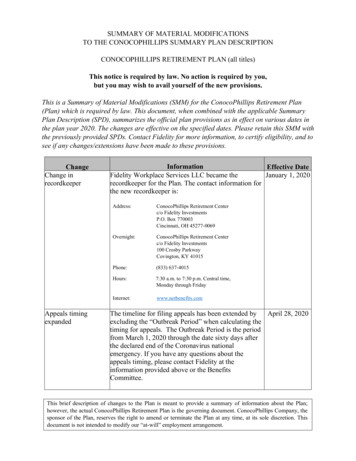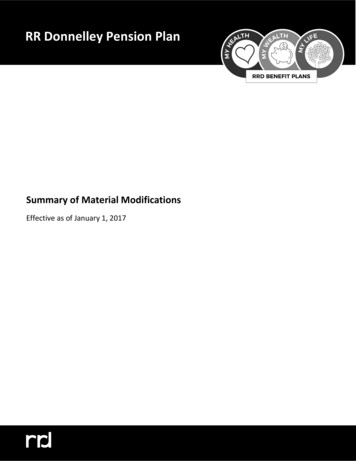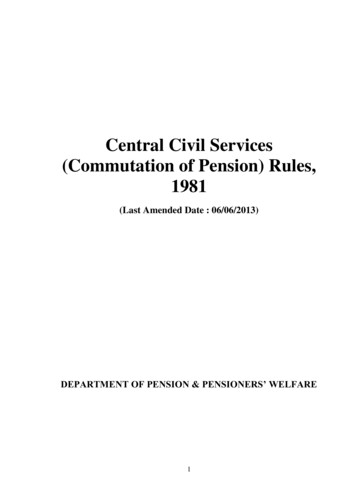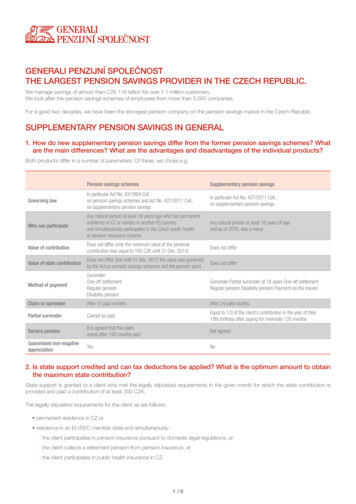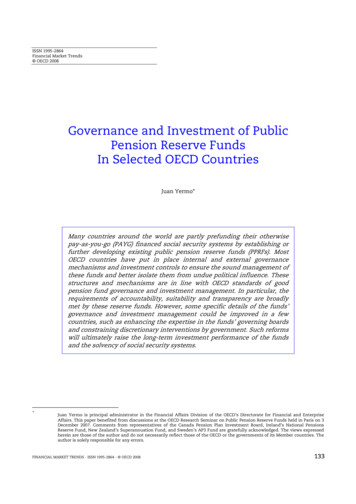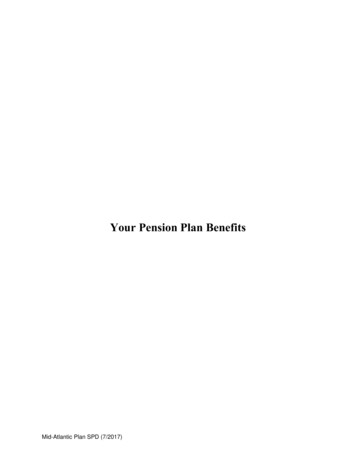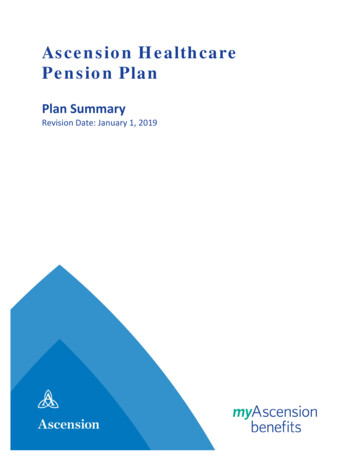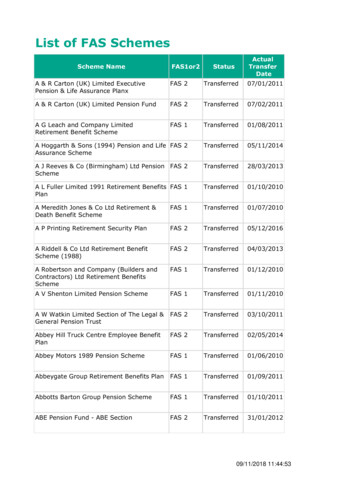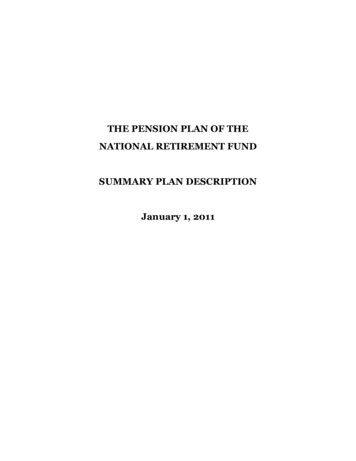
Transcription
THE PENSION PLAN OF THENATIONAL RETIREMENT FUNDSUMMARY PLAN DESCRIPTIONJanuary 1, 2011
HOW TO USE THIS SUMMARY PLAN DESCRIPTIONThis Summary Plan Description or "SPD" is intended to familiarize you with the major provisions of the Pension Planof the National Retirement Fund (referred to as the "Pension Plan" or the "Plan"). You should read this SPD closelyand contact the Plan Administrator if you have any questions (See Section 12).Please remember that like any summary, this booklet is intended to explain a complicated subject in a simple manner.It was prepared in accordance with a Federal law called the Employee Retirement Income Security Act ("ERISA"). Itis not meant to be a replacement for the actual Plan document and it is not meant to interpret, extend or change thePlan document in any way. Every effort has been made to present the Plan in a way that is easy to understand. Certaintechnical terms are necessary to explain the Pension Plan. You should become familiar with these terms in order tomake the fullest use of this booklet. These technical terms are capitalized and are usually explained when they firstappear in the booklet or they are explained in the Glossary section at the back of the booklet (See Section 11).Whenever you come across these words, you may want to refer to the Glossary section to make sure you understandwhat they mean.In case of any conflict between this SPD and the Plan document, the Plan document will govern. The Board ofTrustees of the Plan (the "Trustees") has the sole and absolute discretion to interpret and apply the terms of the Planand the rules there under. This authority includes, but is not limited to, the interpretation and application of theeligibility rules, the manner in which service is credited, status as a covered Participant, benefit levels, and theinterpretation and application of any benefits under the Plan. The Trustees have the final authority in any dispute thatmay arise.The Trustees expect the Plan to continue indefinitely but reserve the right to amend or terminate it at any time.Summaries of any material modifications will be distributed to you. We urge you to keep these materials together withyour SPD for easy reference. If you have any questions, please contact the Plan Administrator to verify that you havethe most up-to-date changes.We suggest that you share this booklet with your family, since they may have an interest in the Plan. We also suggestthat you keep this booklet with your other important retirement papers for future reference and let members of yourfamily know where this booklet is being kept.The Plan is in critical status under the Pension Protection Act of 2006. Under Federal law, the Trustees were requiredto adopt and implement a rehabilitation plan to address critical status funding issues. On April 1, 2010, the Trusteesadopted a rehabilitation plan (the "Rehabilitation Plan"). The Rehabilitation Plan affects the benefits of the Plan'sparticipants and beneficiaries with annuity starting dates on or after June 1, 2010.Effective Date: This booklet describes in easy-to-understand terms the principal features of the Plan as in effect onJanuary 1, 2011. This SPD is intended for employees who earn at least one Hour of Service in Covered Employment onor after January 1, 2011. Some Plan provisions may be different for employees whose employment terminated beforeJanuary 1, 2011, or who entered this Plan from another pension plan that was merged into this Plan prior to 2011(See special rules that apply for prior plans on pages iii-v).Instrucciónes para los Participantes que hablan Español:Nota: En esté folleto encontrará un resumen en Ingles de sus derechos y beneficios bajo el Plan de Fondo de JubilaciónNaciónal. Si usted tiene alguna dificultad comprendiendo alguna parte de esté folleto, por favor contacte al Administradordel Plan de Fondo de Pensión Naciónal. El horario de la oficina es desde las 8:30 am hasta las 4:15 pm, de Lunes aViernes. Vea la Sección 12.ii
PriorPrior Plan RulesIf you worked for an employer that contributed to another pension plan before this Plan, special rules may apply toyou.Look for the icon on the left to find the special rules that apply to your benefit if you work orworked for an employer that contributed to the Hotel Employees and Restaurant EmployeesInternational Union Pension Plan ("HEREIU Pension Plan") prior to October 1, 2007.Look for the icon on the left to find the special rules that apply to your benefit if you work orworked for an employer that contributed to the UNITE HERE National Retirement Fund priorto October 1, 2007.Look for the icon on the left to find the special rules that apply to your benefit if you work orworked for an employer that contributed to the National Pension Plan of the UNITE HEREWorkers Pension Fund ("National Pension Plan") prior to October 1, 2007.If you were a participant in any pension plan that merged with the HEREIU Pension Plan, you may obtainmore information about your pre-merger benefits and special rules that may apply to you from the Plan Administrator. You areentitled to another copy of the SPD that applied to your pre-merged benefits upon written request to the Plan Administrator (aswell as copies of the plan documents and merger agreements). The pension plans that merged with the HEREIU Pension Planprior to October 1, 2007 include:Local 301 Philadelphia, PALocal 100, New York (Locals 1, 2, 11, 15, 60, 69, 70, 71, 89, 164, 302, 325)Local 274, Philadelphia, PALocal 111, Philadelphia, PALocal 217, Hartford, CTLocal 10, Cleveland, OHLocal 158, New JerseyLocal 24, Detroit, MILocal 327, Peoria, ILLocal 868, Toledo, OHLocal 57, Pittsburgh, PALocal 309, Palm Springs, CALocal 1, Local 450, Chicago HotelLocal 1, Local 450, Chicago RestaurantLocal 54, Atlantic City, NJLocal 163, McKeesport, PALocal 267, New Castle, DELocal 737, Orlando, FLDeweys Inc., PhiladelphiaIf you were a participant in any pension plan that merged with the National Pension Plan, you may obtain moreinformation about your pre-merger benefits and special rules that may apply to you from the Plan Administrator. You areentitled to another copy of the SPD that applied to your pre-merged benefits upon written request to the Plan Administrator (aswell as copies of the plan documents and merger agreements). The pension plans that merged with the National Pension Planprior to October 1, 2007 include:iii
American Finishing PlanCapmakers Union Local 17 Retirement PlanCranston Print Works PlanJ.H. Horne Pension PlanLaundry, Dry Cleaning & Dye House Workers Int'l Plan (Local 46)Mid-Atlantic PlanNew England PlanPhiladelphia PlanPhoenix Dye PlanMiami Hotel Industry Pension FundMinneapolis On-Sale PlanMinneapolis Greater Metropolitan Hotel FundSanco Pension PlanSouth Bay (San Jose) HERE Pension Trust FundIf you were a participant in any pension plan that merged with or transferred assets and/or liabilities to the NationalRetirement Fund, you may obtain more information about your pre-merger or pre-transfer, as applicable, benefits and specialrules that may apply to you from the Plan Administrator. You are entitled to another copy of the SPD that applied to your premerged or pre-transferred, as applicable, benefits upon written request to the Plan Administrator (as well as copies of the plandocuments, or pre-transferred, as applicable, merger agreements and/or transfer agreements). The pension plans that haveentered into mergers or transfers of assets and/or liabilities with the National Retirement Fund that will not receive a separateSPD (and for which you may obtain a copy of the pre-merger plan SPD or pre-transfer plan SPD, as applicable) include:Masland Carpets, Inc. Bargaining Employees Pension PlanSanta Monica UNITE HERE Retirement FundGastronomical Union Local 610 and Metropolitan Hotel Association Pension FundLaundry & Dry Cleaning Pension Plan (Local 107)SEIU National Industry Pension Plan (Yosemite)If you were a participant in one of the following plans that merged into the National Retirement Fund, you will receive a separateSPD (in which case you should not use this SPD) or a separate schedule of provisions which will supplement this SPD explainingthe different rules that apply to you:Council No. 13 ACTWU– Shoe DivisionConsolidated Plan, National Retirement Fund, Headwear DivisionRetirement Plan of Local 340ARetirement Plan of the Neckwear Workers Fund, Headwear DivisionRetirement Plan of the New England Laundry FundRetirement Fund of the Cloth Hat and Cap Industry of New YorkRetirement Plan of Local 352Amalgamated Cotton Garment and Allied Industries Retirement FundPension Fund of the ACTWU Employees' Retirement Income Plan, Detroit, MIValley Laundry and Dry Cleaning Pension Plan (Local 75)ILGWU National Retirement FundPension Plan of Indianapolis Cleaners and Launderers Club and Laundry and Dry Cleaning Local 3017Textile Processors, Service Trades, Health Care, Professional and Technical Employees Int'l Union, Local 108 Pension PlanAFL-CIO Combination Dry Cleaners, Launderers and Service Store Employees Local Union No. 168 Pension PlanAFL-CIO Laundry and Dry Cleaning International Union Local No. 39Pension Plan Local No. 3008 Laundry and Allied Trades Pension PlanMinnesota Laundry and Health Care Workers PensionRetirement Plan of the UNITE Washable Clothing, Sportswear and Allied Industries FundLocal 4-69 Pension Plan of the Hotel & Restaurant Employees & Bartender Union, AFL-CIOiv
Local 218 and Linen Service and Industrial Laundry Employees Retirement PlanUNITE Local 10 and the Textile Maintenance Industry of Philadelphia & Vicinity PlanHERE Union Local 54 Pension PlanPension Plan for the Laundry & Dry Cleaning Workers Pension Trust (Local 52)Local 125 Pension FundRetirement Fund of Local 102 ILGWUAlaska Hotel and Restaurant Employees Pension PlanSidney Hillman Medical Center Employees' Retirement PlanUpstate NY Employees and Restaurant Employees' Retirement Plan (Local 471)v
TABLE OF CONTENTSSection 1. - PARTICIPATION AND COVERAGE . 1What is the Pension Plan? . 1Do I get a pension benefit because I pay union dues?. 1Do I make contributions into this Plan? . 1When do I become a Participant of the Pension Plan? . 1What benefits does the Plan provide? . 1Does the Plan provide benefits for my Spouse? . 1Are Domestic Partners covered by the Plan? . 2Does the Plan provide benefits for my Beneficiary? . 2Section 2. - VESTING . 3When do I become Vested in my Pension Plan benefit? . 3How are Hours of Service counted? . 3Can I get Vesting Service credit for a part of a year?. 3Can I get Vesting Service credit for an Excused Absence? . 3Do I get any credit for my Service with another Pension Plan? . 4What is a Break in Service and how can a Break in Service affect me? . 5Section 3. - HOW YOU EARN CREDIT FOR A PENSION . 6What is Credited Service? . 6What is Future Service? . 6Can I get Future Service credit for a part of a year?. 6What is Past Service?. 6Section 4. - THE REHABILITATION PLAN . 8What if I am covered by the Preferred Schedule? . 8What if I am covered by the Default Schedule? . 8What if I am not covered by either the Preferred Schedule or the Default Schedule? . 9Section 5. - THE TYPES OF PENSIONS AVAILABLE. 10An Overview of the Different Types of Pension Benefits . 10Your Normal Retirement Pension Benefit . 11Accruals After Normal Retirement Date . 11Your Disability Retirement Pension Benefit . 20When Disability Retirement Benefits End . 20Your Early Retirement Pension Benefit . 21Your Deferred Vested Pension Benefit . 22Section 6. - THE DIFFERENT PENSION PAYMENT OPTIONS . 24What are the Normal Forms of Payment for Participants covered by thePreferred Schedule? . 24The Single Life Annuity . 24The Joint and 50% Survivor Annuity Benefit . 24Rejecting the Joint and 50% Survivor Annuity . 24vi
TABLE OF CONTENTSWhat are the Normal Forms of Payment for Participants covered by theDefault Schedule? . 25The Single Life Annuity . 25The Joint and 50% Survivor Annuity Benefit . 25Rejecting the Joint and 50% Survivor Annuity . 26What are the Optional Forms of Payment? . 26The Joint and 75% Survivor Annuity Benefit . 2610-Year Certain Pension (120 Guaranteed Monthly Payments) . 27Small Lump Sum Payment . 27Relative Value . 27Section 7. - PAYMENTS AT DEATH . 28Section 8. - HOW TO APPLY FOR A PENSION . 30If you apply after your Normal Retirement Date . 31If you apply for a Disability Retirement . 31If your Survivor Annuitant applies for Benefits . 32Section 9. - OTHER INFORMATION . 33When Do You Need Your Spouse's Consent? . 33Naming Your Beneficiary . 33Minimum Distributions . 34May I have my pension benefit payments deposited in my bank account? . 34Are my benefits taxable? . 34When are benefits not paid?. 35Right of Recovery . 35Keep Your Information with the Plan Administrator Up to Date . 35Section 10. - HOW YOUR RIGHTS ARE PROTECTED . 36Your Rights Under ERISA . 36Your Right to Appeal . 37Your Rights Under the Social Security Act . 38Your Rights Under USERRA. 39Your Rights with Respect to the PBGC . 39Rights to Employment . 39Non-Assignability of Benefits . 40Plan Amendment . 40Plan Termination . 40Section 11. - GLOSSARY OF TERMS. 41Section 12. - MORE FACTS ABOUT THE PLAN . 44vii
SECTION 1. - PARTICIPATION AND COVERAGEWhat is the Pension Plan?The National Retirement Fund provides a defined benefit pension plan to assist you financially when you meet certaineligibility requirements and you reach retirement age or if you should become disabled and cannot continue to work.The Pension Plan pays you a regular monthly income in addition to any benefit you are entitled to receive from SocialSecurity. Plan benefits are provided at no cost to you.Do I get a pension benefit because I pay union dues?No. Your union dues do not provide pension benefits, and union membership, by itself, has no bearing on whether ornot you earn pension benefits. Pension benefits are provided only if a Participating Employer makes contributions tothe Plan and you have earned the required amount of service. A Participating Employer is any employer having acollective bargaining or participation agreement in which the employer agrees to make contributions to the Plan.Do I make contributions into this Plan?No. Participant contributions are not allowed. Pension benefits are provided solely through contributions from aParticipating Employer. Upon written request, the Trustees will make available a complete list of the employerscontributing to the Plan and a copy of the collective bargaining or participation agreement between the Union andyour employer.When do I become a Participant of the Pension Plan?To become a Participant of the Pension Plan, your employer must be obligated to contribute to the Pension Plan onyour behalf, pursuant to a collective bargaining or participation agreement, and you must complete at least 800 Hoursof Service (750 hours if your collective bargaining agreement reports Straight Time Hours) in Covered Employment.In your first year of Covered Employment, for purposes of participation, a year means the 12-month period measuredfrom your first day of work in Covered Employment. Thereafter, a year means the calendar year. Once you meet theabove requirements, your participation in the Plan is automatic. There are no forms for you to complete.What benefits does the Plan provide?The Plan provides monthly annuity benefits guaranteed for your lifetime if you meet certain requirements. Benefits arepayable to Participants who retire at Normal Retirement, Early Retirement or to Participants who are eligible andqualify for Disability Retirement. The Plan also provides benefits to your Spouse, Domestic Partner or Beneficiary,depending on the optional form of payment elected.Does the Plan provide benefits for my Spouse?Yes. The Plan will generally pay a benefit to a Participant's Spouse if certain conditions are met. If you die afterretirement payments have begun and you had elected a Joint and Survivor Annuity with your Spouse, reduced survivorpayments will continue to your Spouse until his/her death. Upon your death, your Spouse must contact the PlanAdministrator to provide the required information and to fill out the necessary forms.1
Are Domestic Partners covered by the Plan?Yes. The Plan will pay a benefit to a Participant's Domestic Partner if certain conditions are met. Upon your death,your surviving Domestic Partner (if any) must contact the Plan Administrator to provide the required information andto fill out the necessary forms. If you die after retirement payments have begun and you had elected a Joint andSurvivor Annuity with your Domestic Partner, payments will continue to your Domestic Partner until his/her death.However, if you selected a benefit option, began receiving your retirement benefits and did not name your DomesticPartner as your Survivor Annuitant or Beneficiary, your Domestic Partner is not entitled to any benefits from thePlan.Does the Plan provide benefits for my Beneficiary?Yes. The Plan will generally pay a benefit to a Participant's Beneficiary if certain conditions are met. If you die afterretirement payments have begun, the payment option that you chose at retirement will determine what benefits, if any,will be payable to your Beneficiary. Upon your death, your Beneficiary must contact the Plan Administrator toprovide the required information and to fill out the necessary forms.2
SECTION 2. - VESTINGWhen do I become Vested in my Pension Plan benefit?Vesting Service is the number of years used to determine if you qualify for a pension benefit. You are Vested when youhave 5 years of Vesting Service. Once you are Vested, your pension benefits cannot be lost.You are credited with one full year of Vesting Service if you complete at least 800 Hours of Service in a calendar year(750 Hours of Service if Straight Time Hours) for one or more Participating Employers.How are Hours of Service counted?An Hour of Service means any hour for which you actually work and any hour for which you are entitled to be paid. Ifyour Participating Employer is not required by the collective bargaining or participation agreement to report youractual hours worked to the Plan Administrator, the Plan Administrator will use one of the following equivalencymethods to determine your hours worked: 10 hours if you are credited based on days of employment or per job; or45 hours if you are credited based on weeks of employment; or190 hours if you are credited based on months of employment.Can I get Vesting Service credit for a part of a year?Yes. You may receive Vesting Service for part of a year. The following chart shows how partial Vesting Service creditis given.Hours of Service Completedwithin a Calendar YearVesting Service Crediton and after 1/1/080-499500-799800 or more0 credit0.50 credit1.00 creditCan I get Vesting Service credit for an Excused Absence?For purposes of determining Vesting Service, you may receive credit for up to 501 Hours of Service per year duringwhich you were not actually at work including paid vacation, certain absences (sickness, accidents, military andmaternity/paternity leave) and approved leaves of absence for union business. The 501 Hours of Service may alsoinclude time you were absent from work, whether you were paid or not, under the Family and Medical Leave Act of1993. Vesting Service may also include any number of hours that you did not work but for which you were awardedback pay or your employer agreed to give you back pay.3
Under certain circumstances you may be entitled to past Vesting Service for Covered Employment:HEREIU Pension Plan: If you work for an employer that started contributing to the HEREIU Pension Planon or after January 1, 1994, you may receive additional Vesting Service based on your employment before contributions began. Toqualify you must earn 3 years of Vesting Service after contributions began and your employer must provide evidence that you wereworking when contributions began. The amount of additional Vesting Service you receive is equal to your length of continuousemployment before contributions began, but is generally limited to 2 years of Vesting Service.Chicago Sheraton : The Chicago Sheraton began contributing to the HEREIU Pension Plan on December 1, 1995. However,you may receive up to 2¼ years of Past Vesting Service for continuous employment at the Chicago Sheraton before December 1,1995.Hyatt Regency McCormick Place : If you were employed at the Hyatt Regency McCormick Place on February 1, 2000 and youremployer contributed to the HEREIU Pension Plan under a HEREIU collective bargaining agreement, you may be eligible for up to18 months of past Vesting Service for continuous employment at the Hyatt McCormick before February 1, 2000.Do I get any credit for my Service with another Pension Plan?For purposes of determining eligibility for retirement benefits and Vesting Service (but not for benefit calculationpurposes or benefit amounts), service shall be recognized if you worked for a Participating Employer in the"reciprocal" funds listed in the chart below. You may also be eligible to receive a benefit from the "reciprocal fund"based on the rules of that fund.RECIPROCAL FUNDS Amalgamated Insurance FundAmalgamated Retail Retirement FundLaundry, Dry Cleaning Workers and Allied Industries Retirement Fund, Workers UnitedAmalgamated Clothing Workers Retirement Fund of OntarioAmalgamated Clothing Workers Retirement Fund of Providence of QuebecLocal 324, ACWA Insurance Fund (Laundry Drivers)Amalgamated Clothing Workers Local 459 and Garment Manufacturer Health, Welfare and Pension Fund, Inc. (Winnipeg,Manitoba, Canada)Amalgamated Department Store and Retail Employees Insurance FundHartmarx Retirement Income FundNational Plus PlanService Employees International Union Master Pension Plan (SEIU)Consolidated Retirement PlanAny plan that has merged into this PlanAny other plan maintained pursuant to a collective-bargaining agreement to which the Union is or was party, provided thatthese plans include reciprocal pension provisions.4
What is a Break in Service and how can a Break in Service affect me?A Break in Service occurs in each year during which you do not complete at least 400 Hours of Service in CoveredEmployment (375 hours if Straight Time Hours). If you are not Vested in a pension benefit and if you have 5consecutive one-year Breaks in Service, which is a permanent Break in Service, then you will lose your years of serviceand your status as a Participant and you cannot have them restored.If you have returned to Covered Employment after having one or more Breaks in Service, you must complete 400 Hoursof Service in Covered Employment (375 hours if Straight Time Hours) in the 12 consecutive month period beginningon the date you return to Covered Employment. This will allow you to become a Participant again and to have yourservice restored as long as you did not have a permanent Break in Service.Below is an example of a permanent Break in 00001This Participant earned 4 years of VestingService when her employment ended which is notenough to be Vested.}After an absence during which 5 consecutive oneyear Breaks in Service occurred, she lost her 4years of Vesting Service. Then she returned toCovered Employment.4 Years VestingService}5 consecutiveone year Breaks in Service Permanent Breakin ServiceBecause a permanent Break in Service occurred,she will need to become a Participant and startearning Vesting Service and Future Service allover again.Participant returns t
Retirement Plan of the New England Laundry Fund Retirement Fund of the Cloth Hat and Cap Industry of New York Retirement Plan of Local 352 Amalgamated Cotton Garment and Allied Industries Retirement Fund Pension Fund of the ACTWU Employees' Retirement Income Plan, Detroit, MI Valley Laundry and Dry Cleaning Pension Plan (Local 75) ILGWU .



